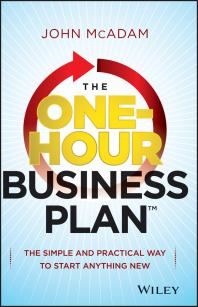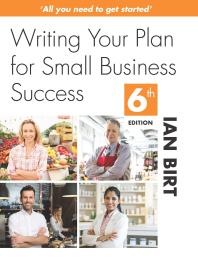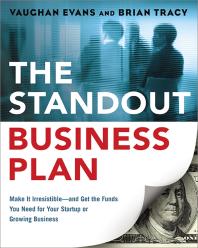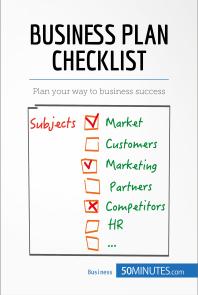What is a Business Plan?
A Business Plan is a strategic roadmap for any new or growing business or startup venture. It captures the opportunity you see for your company: it describes your product or service and your business model, the target market you’ll serve. It also includes details on how you’ll execute your plan: how you’ll price and market your solution, and your financial projections.
A good plan guides you through each stage of starting and managing your business. You’ll use your business plan as a roadmap for how to structure, run, and grow your new business. It’s a way to think through the key elements of your business.
Business plans can help you get funding or bring on new business partners. Investors want to feel confident they’ll see a return on their investment. Your business plan is the tool you’ll use to convince people that working with you — or investing in your company — is a smart choice.
A business plan can't be a tightly crafted prediction of the future but rather a depiction of how events might unfold and a road map for change.
There are generally two types of business plans:
- Traditional business plan that is very detailed, It takes more time to write, and is comprehensive including an executive summary, company description, market analysis and more. Lenders and investors commonly request this plan. You use a traditional business plan if you need to be very detailed or plan to use traditional funding sources for your business.
- Lean start up format plan that is high-level focus, fast to write, and contains key elements only. Some lenders and investors may ask for more information Lean start up format plans are for when you need to explain or start your business quickly, your business is relatively simple, or you plan to regularly change and refine your business plan
Adapted from SBA.gov, HBS.edu, Bplans.com.
What Does a Business Plan Look Like?
Most Business Plans include:
-
Table of Contents
-
Executive Summary: Appears first, written last. Provides a snapshot of your company explaining who you are, what you do, and why.
-
Mission & Vision: Here you define the purpose of your business (Mission) and a statement about your perception of the company's growth and potential (Vision). Include specific goals and objectives of the business
-
Business Description: Provide background information about the company including brief history of the business and list of key company principals.
-
Define Your Market: Describe the industry within which your business will operate, identify your target market, provide a general profile of your targeted clients, and describe what share of the market your currently have and/or anticipate. For this section of the business plan, your will undertake following types of research:
-
Industry Analysis: how is the industry structured, trends and statistics, key players, segmentation, sales and distribution channels etc.
-
Competitive Analysis: major competitors, strengths and weaknesses, how would you position yourself against the competition, market niche, product/service comparison
-
Customers: who are the customers (demographic data), what do they want, customer buying habits, market share/market size, consumer preferences
-
Advertising and Promotion: How will you reach out to potential customers? Where do they currently shop for product/service? Where will you advertise and how will you measure the effectiveness of your advertising and promotion efforts?
-
Pricing: strategy, policies, price list, break-even analysis
-
Location: Where is your business located? (home-based; retail; commercial, etc….), is the location of your business important? Any special zoning, land or building improvements needed to accommodate your operation? If location is important, what are the features of your location?
-
Products & Services: Describe all your products and services; explain how your products and services are competitive including unique features, benefits of the product or service, niche served, stage of product/service development, production, future growth.
-
Organization & Management: Describe how your company is organized including legal structure(sole proprietorship, partnership, corporation etc); identify any special licenses and/or permists your business operates with; provide brief bio of key managers within the company; include an organization chart if available.
-
Marketing & Sales Strategy: Identify and describe your maket -- who are your customers and what's the demand for your products and services; channels of dsitribution you will use; your sales strategy specific to pricing, promotion, products, and place.
-
Financial Management:
-
For new business include: estimate of start-up costs (all one-time expenses such as equipment, deposits, fees, etc.); projected balance sheet, income statement, cash flow statement (1 year forward)
-
For existing business include: balance sheets (last 3 years), income statements (last 3 years), cash flow statements (12 months)
-
If applying for a loan: current personal financial statement on each principal; federal tax return for prior year
-
-
Appendices: This section may include company brochures, resumes of key employees, list of business equipment, copies of press articles and advertisements (if available), pictures of your business location and products, any applicable information about your industry and /or products, key business agreements such as lease, contracts etc.
(Adapted from: SBA's Business Plan Template)
-
Sample Business Plan by Category via BPlansTo download plans, you must provide an email address.
Business Plan Books

The One-Hour Business Plan : The Simple and Practical Way to Start Anything New by John McAdam
Available online. With the help of this book, aspiring entrepreneurs can write a viable business plan in just one hour. Offers step-by-step guidance on the process of writing a business plan, with field-tested instructional techniques that are simple, strong, and easy to implement.

Writing Your Plan for Small Business Success by Ian Birt
Available online. This widely used, practical guide shows you how to prepare an effective business plan to obtain a loan and get your business off the ground. It includes: step-by-step guidelines to create a business plan; sample business plans for a range of business types; examples, exercises, quick quizzes, activities and web references; a list of environmentally sustainable business practices; options for marketing, production, purchasing, staffing and financing; what to do when business conditions change.

The Standout Business Plan : Make It Irresistible and Get the Funds You Need for Your Startup or Growing Business by Vaughan Evans and Brian Tracy
Available online. The Standout Business Plan is an immensely practical and readable guide that shows readers how to create a business plan that not only speaks directly to investors and lenders but also makes it easy for them to say yes.

How to Write a Business Plan by Brian Finch
Available online. This book is aimed equally at the novice or those who have written business plans before. The novice does not know and needs some help while the experinced executive may have forgotten some of the basic lessons - we all get complacent over time.

The perfect business plan made simple by William Lasher
Available in Verdugo Library: Call number: 658.4012 L343p. The Perfect Business Plan Made Simple approaches the business plan as a sales document that will persuade bankers and venture capitalists to invest in your new or growing enterprise. Featuring examples and detailed sample plans, this updated edition addresses legal concerns and special issues unique to internet-based businesses.
How to write a business plan by Mike P. McKeever
Available in Verdugo Library: Call number: 658.15224 M154h, 2017. This bestselling book contains clear step-by-step instructions and forms to put together a convincing business plan with realistic financial projections, effective marketing strategies, and overall business goals.

Business Plan Checklist : Plan Your Way to Business Success by 50MINUTES
Available online. This book is a practical and accessible guide to understanding and creating a business plan checklist, providing you with the essential information and saving time. In 50 minutes, you will be able to understand 9 key steps to business plans, user your plan to guide products and business ventures, and grab the interest of investors.